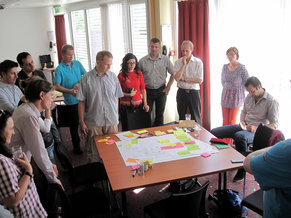 |
A-Z | Popular | Blog | Projects | Search » |
|
Project Management  Related Guides
Project Management
Key Concepts
Project Metrics  Project Management
Program Management Examples  Program Management Process  Project Quality  Schedule Compression  Project Risk  Scrum  Requirements  Stakeholder Management  Issue Management  Estimates  Project Charter  |
77 Types of Project Failure John Spacey, updated on
A project is a failure when it is not delivered to expectations. That is to say, a project fails when it is perceived to have failed by sponsors and other key stakeholders. The symptoms of project failure may include cost overruns, missed dates, business disruption and damaged reputation. Common causes of project failure include:
Acceptance CriteriaUndefined or open ended acceptance criteria.Architecture And DesignArchitecture and design that fails to support requirements or that is so problematic that it delays the project.AssumptionsIncorrect or undocumented assumptions.Benefits RealizationThe project fails to deliver the benefits stated in its business case. In some cases, projects that deliver to cost, time and specifications are widely perceived as a failure because benefits fall short of promises made by the sponsor.Big Bang AdoptionSuccessful projects typically ship often. Large launches that have significant impact to processes tend to fail.Budget CommitmentA project that runs out of funding in the middle due to a lack of financial commitment.Budget ControlFailure to control the project budget resulting in loss of financial confidence in the project and the need for an audit.Business Technology AlignmentImplementing a technology that the business doesn't need or implementing a business requirement without considering technology. For example, launching a new product without considering the need to integrate into customer management and billing systems.Change ControlChange control issues and overhead. For example, a constant stream of change requests may distract the project team from meeting baseline commitments.CommunicationUnder-communicating such as burying important information in documentation instead of communicating it verbally.Contingency ReserveA budget and timeline that lack reserves for the inevitable issues that projects face.Corrective ActionsManagement of issues when they occur. A project that quickly clears issues is far more likely to succeed than one that endlessly deliberates with each issue.Cost VarianceCosts that exceed estimates.CrashingAn attempt to speed a project up by adding more resources. Known to be a failure prone approach but organizations tend to do it anyway.Data QualityAnalysis of data is a fundamental project planning step that's occasionally neglected. In some cases, high impact data issues aren't noticed until launch.Due DiligenceDue diligence is a basic level of effort and care that's expected of an organization or professional. Its neglect can cause serious project issues.Engagement And MoraleA project team that is overworked or mistreated may have low engagement and poor morale. In some cases, poor morale is caused by a series of project failures. This can become a vicious cycle whereby project failures decrease morale causing more project failures.EstimatesAccurate estimates for large projects are something of a rarity. As such, padding estimates is a common practice that may improve a project's chance of succeeding.Executive CommitmentSufficient support at the executive level improves a project's chance of success. In some cases, a single executive can throw up enough roadblocks to derail a project even when others support it.Executive SponsorThe executive sponsor plays a key role in championing a project and pushing through issues. When this doesn't happen, a project may fail.FeasibilityAn approach or requirement that isn't properly validated that turns out to be impossible or highly impractical.Fixed PriceFixed price contract projects are subject to a variety of problems. They tend to result in an adversarial relationship whereby the client pushes the vendor hard on every point in the contract and the vendor pushes hard against any changes. This results in a number of factors that may destroy the project such as refusals to accept deliverables and inability to implement change requests at a reasonable price.Goal SettingStakeholders who don't have the project properly reflected in their goals for performance evaluation.Information SecurityInformation security is a critical component of corporate governance. As such, incorporating security into designs, testing and validations is basic due diligence. Failure to address information security may result in a project being halted by corporate governance bodies. In the worst case, a project creates a vulnerability that results in a security incident and reputational damage to an organization.Integration ComplexityThe complexity of integrating organizations, processes and systems is often underestimated and a common cause of project failure.Issue ManagementIssues that are covered up or mismanaged.LeadershipLack of a strongly committed and active leader who has the authority or influence to advance a project in the face of obstacles. In many cases, a strong technical leader with a solid architectural vision also greatly improves a project's chances of success.Loss LeaderA fixed price contract with a price below the vendor's likely costs. Gives the vendor pressure to cut corners, overprice change requests and assign low cost resources.Market ConditionsMarket conditions such as a recession or the release of an innovative product by a competitor may lead to a sudden decline in commitment to a project as its business case starts to look less realistic.MethodologyProject management methodology lapses such as a lack of risk management. For example, executives may impose shortcuts or an organization may lack mature project management capabilities.Metrics And MeasuresProject metrics that fail to represent the project in a balanced and realistic way. For example, a project dashboard that is somehow completely green when there are critical issues.Mission & VisionA project that lacks a mission and vision as motivating factors. People want to know what a project is trying to achieve.NarrativeA well communicated narrative that clearly illustrates the urgent business need for a project can improve commitment and reduce resistance to change. If a project doesn't clearly present its own narrative, a narrative may develop in the realm of rumor and complaints. When a project is widely viewed as a mistaken strategy people may try to derail it.Non-Functional RequirementsMissing non-functional requirements.Operational AcceptanceProjects that engage operations too late or fail to establish or meet operational acceptance criteria.Operational CapabilitiesDeployment of a project to an organization that lacks the capabilities required to operate it.Optimism BiasIt's common for optimism bias to influence things such as requirements, estimates and designs in the early stages of a project.Organizational CultureA project that's inconsistent with the values, ethics, norms, habits and expectations of its organization is likely to be rejected or derailed.OvertimeOvertime can be effectively used to overcome project issues. However, when it's overused and mandatory it can severely impact morale.Performance ManagementIn some cases, projects are detached from performance management to the extent that low performance isn't handled and exceptional performance isn't rewarded. In many cases, performance management is administered by functional managers who may not collect or consider feedback for project work.Political InfightingPolitics between stakeholders can lead to inefficient decision making, irrational approaches, secrecy and resistance to change.Process ComplianceA project that fails to adhere to organizational processes such as budget approvals, financial reporting, audits or technology compliance reviews.ProcurementA project that skips steps in procurement resulting in poor vendor selection or compliance issues.Program ManagementCoordination problems with related projects such as failed dependencies.Project ComplexityPerhaps the greatest risk factor for project failure is project complexity. Projects that are decomposed into small work packages that are continually integrated and shipped are far more likely to be successful than projects that work with large releases.Project ConstraintConstraints such as hard deadlines often generate significant risks that set a project up for failure from the start.Project ExpectationsStakeholders including core team members commonly develop expectations that are out of line with project realities. In many cases, these are incorrectly assumed to be common sense or self evident. Invalid expectations can cause a broad range of project issues related to requirements, designs, deliverables and acceptance criteria.Project GovernanceGovernance that is unwilling or slow to step in to handle issues of accountability or to clarify ground rules for decision making.Quality ControlFactors such as low quality deliverables and poorly constructed test cases.Requirements QualityRequirements that are unclear, open-ended or contradictory. In many cases, requirements are validated individually without a sanity check or strong owner who ensures they make sense as a cohesive set.Residual RiskThe risk that remains after you treat risk.Resistance To ChangeThe general tendency for people to resist change, particularly when they aren't engaged. Resistance to change can manifest itself as open opposition to a project or passive aggressive actions that attempt to derail it.Resource OverallocationResources who are overallocated on the project, by their functional manager or both.Return On InvestmentIn some cases, the return on investment presented in a project's business case is invalidated resulting in declining commitment.Risk AcceptanceWhen stakeholders accept significant levels of risk it becomes likely the project will fail.Risk IdentificationFailure to identify significant risks that go unmanaged until they cause an issue.Risk ManagementRisk management as a one time activity that fails to control risks from new sources such as change requests.Roles & ResponsibilitiesUnclear or poorly structured accountability and responsibility for decisions and work.Schedule ChickenWhen multiple teams are behind schedule but nobody wants to be first to admit it.Schedule CompressionSchedule compression is the practice of trying to deliver a project faster using techniques such as fast tracking and crashing. It typically puts a project at greater risk of failure.Scheduling ErrorsAn error in a project schedule such as an invalid critical path.Scope CreepUncontrolled change or continuous growth in scope.Secondary RiskA new risk that results from efforts to avoid, mitigate, transfer or share risk.Secrecy And SubterfugeA lack of open information sharing between stakeholders or between project leaders and working level teams.Set Up To FailA project that has been intentionally designed to fail as a political strategy.Stakeholder AnalysisMissing stakeholders that need to be consulted.Stakeholder CommitmentAloof stakeholders who fail to fulfill their role or who develop wild expectations due to a lack of communication such as skipping meetings.Stakeholder SalienceA stakeholder who takes a dominant role in the project potentially shutting out other voices that have a more critical stake in the project.Strategy AlignmentA project that is based on someone's personal vision instead of organizational goals and strategy.Subject Matter ExpertsA lack of expert advice in a critical area such as architecture or security.Technology ComponentsFailure of a key technology component.Technology PlatformProblems with a technology platform can make deliverables late and result in quality issues. In some cases, a project budget fails to anticipate the costs associated with a particular platform such as the need for highly specialized resources.Training And DevelopmentTraining failures related to the project team or end users.Vendor ManagementFailure to manage a vendor.Vendor RelationshipsA poor relationship with a vendor can result in severe issues and low productivity.White ElephantA project that becomes an escalating commitment as new money is spent to try to recover sunk costs. Has the potential to turn a minor failure into an impressive one.WorkaroundsTactical actions that fail to address an issue or that make things worse.Project ManagementThis is the complete list of articles we have written about project management.If you enjoyed this page, please consider bookmarking Simplicable.
Project RiskA list of common project risks.Project Management BasicsA list of basic project management techniques.Workaround
A definition of workaround with examples.
Project Branding
A list of project branding techniques.
Stakeholder ManagementAn overview of project stakeholder management with examples.Action PlanA definition of action plan with examples.Cost Overrun
The primary types of cost overrun.
Document ControlThe definition of document control with examples.Project Oversight
A guide to project oversight.
Design-Driven Development
A definition of design driven development with examples.
Project RiskA list of common project risks.Project StakeholderA list of common project stakeholders.Business RisksA list of common business risks.Risk vs Issue
The difference between a risk and an issue.
Risk TreatmentThe five things that can be done about risk.Secondary Risk
The definition of secondary risk with examples.
Risk Register
A guide to creating a risk register with an example.
Risk Perception
A definition of risk perception with examples.
ImplementationThe common types of implementation.Project Risk Management
A reasonably complete guide to project risk management.
TrendingThe most popular articles on Simplicable in the past day.
New ArticlesRecent posts or updates on Simplicable. Site Map
© 2010-2023 Simplicable. All Rights Reserved. Reproduction of materials found on this site, in any form, without explicit permission is prohibited. View credits & copyrights or citation information for this page. |